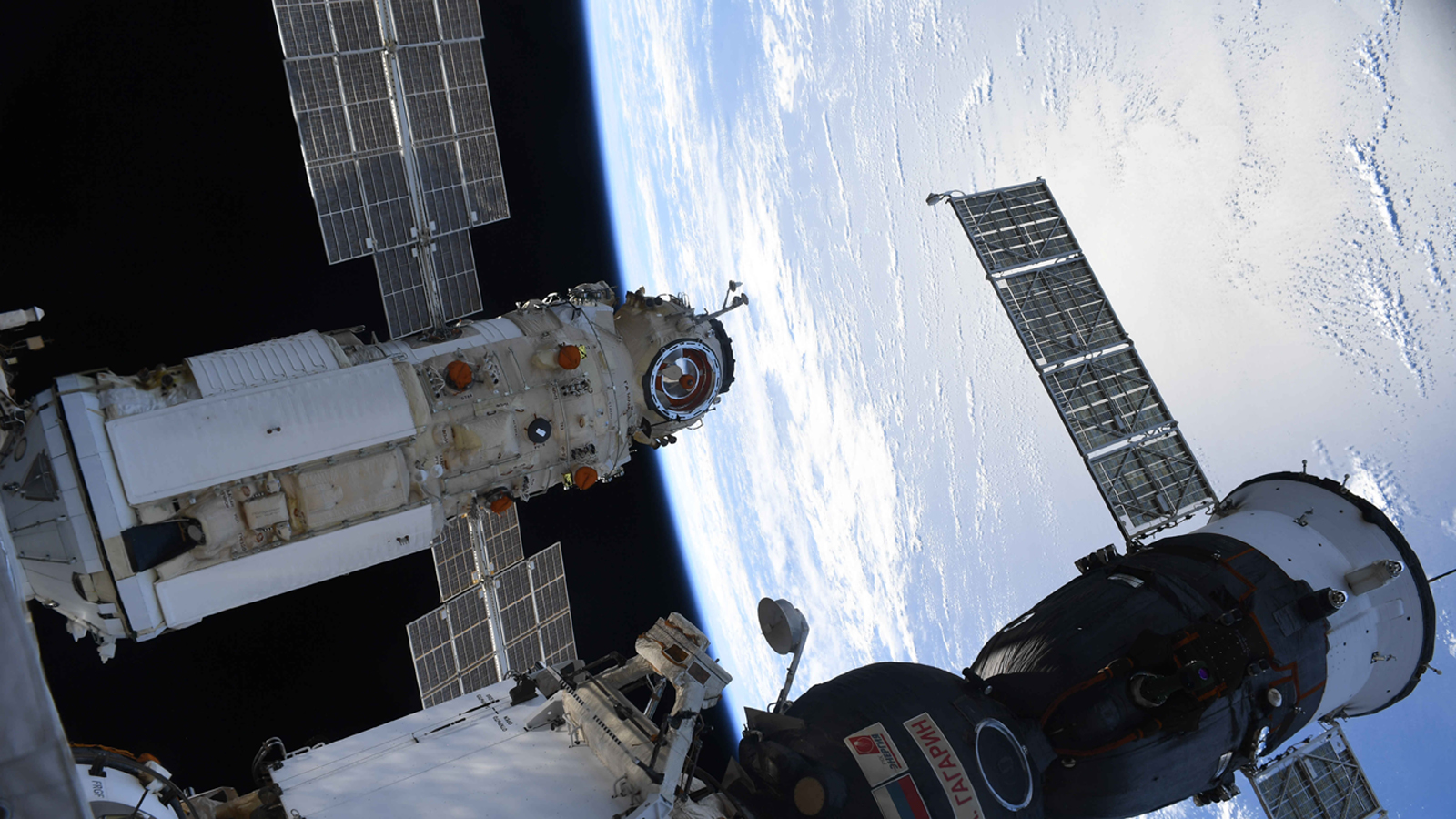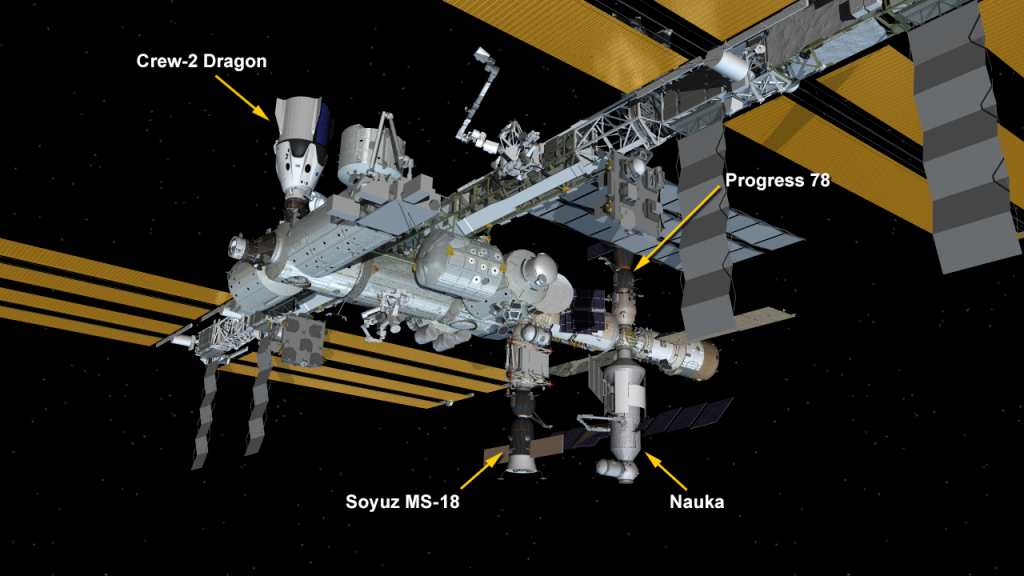Space Station tumbled end-over-end due to Russian module thruster glitch
Meteorologist/Science Writer
Wednesday, August 4th 2021
This was possibly the worse emergency the space station suffered in its 20+ years of operation
A computer glitch has been blamed for the incident, which saw the International Space Station flip end-over-end in orbit.
Early in the morning on July 29, 2021, a new section of the space station arrived and docked to the Russian end of the orbital outpost. Nauka, or наука ("the science" in Russian), is also named the Multipurpose Laboratory Module (MLM).

Nauka docked with the ISS, with Soyuz MS-18 at the lower right. Credit: Roscosmos
A few hours after its arrival, while the Russian cosmonauts were checking Nauka's connections to the rest of the station, a computer glitch caused its thrusters to suddenly begin firing. Emitting a continuous stream of thruster gas, Nauka began pushing the station out of alignment, resulting in it tumbling end-over-end as it orbited the planet.
The crew on the ground - both at Roscosmos and NASA - worked quickly to get the situation under control. With no apparent way to turn off Nauka's thrusters, Roscosmos first activated the thrusters on the Zvezda Service Module in an attempt to counter-balance the thrust from Nauka. To gain the upper hand, though, they also switched on the thrusters of the docked Progress 78 cargo ship, currently on the exact opposite side of Zvezda from Nauka.

This computer simulation of the ISS shows the location of the new Nauka module in relation to the spacecraft currently docked or berthed at the station. In preparation for this docking manuever, the station was travelling in this orientation towards the right of the image, with Russian section as the leading end. Credit: NASA
In a report on Monday, Roscosmos called the problem "a short-term software failure."
Although NASA initially reported that the station was knocked only about 45 degrees out of position by Nauka's thrusters, it turned out to be quite a bit more once they assessed the incident in the aftermath.
Talking to the New York Times, NASA flight controller Zebulon Scoville said that the unexpected thrust resulted in the station performing a slow backflip. At around half a degree per second, the ISS turned a total of 540 degrees before the combined counter-thrust from Zvezda and Progress 78 could stop it.
From there, with still no way to shut down the out-of-control thrusters, they simply had to wait until Nauka ran out of fuel.
Now, flipping over is not unusual for the space station. It apparently performed a 180-degree flip sometime before Nauka's arrival to orient the Russian part of the station as the leading end. However, even though the station ended up roughly in its usual orientation (with Zvezda as the trailing end) by the time this incident was over, having your football-field sized orbital lab flip end-over-end one and a half times is not an ideal situation.
"This is one of the more serious incidents in the 24-year-history of the ISS," Jonathan McDowell, an astrophysicist at the Harvard-Smithsonian Center for Astrophysics, told George Dvorsky at Gizmodo. "The loss of attitude control in principle risks breakup of the complex."
With the incident now over, the station crew has accessed Nauka and are integrating it into the station. According to NASA, Nauka will serve as a new science facility, docking port, and spacewalk airlock for future operations.
Impact of space station spin requires study, official says
Vladimir Isachenkov
The Associated Press
Published Wednesday, August 4, 2021

Nauka module approaches the International Space Station space station, on July 29, 2021. (NASA via AP)
MOSCOW -- Space engineers will analyze whether a glitch that caused the International Space Station to spin out of its normal orientation could have impacted any of its systems, a Russian space official said Wednesday.
Sergei Krikalev, the director of crewed space programs at the Russian space corporation Roscosmos, emphasized that last week's incident did not inflict any observable damage to the space station but he said that experts would need to study its potential implications.
"It appears there is no damage," Krikalev said in an interview broadcast by Russian state television. "But it's up to specialists to assess how we have stressed the station and what the consequences are."
NASA emphasized Wednesday that the station was operating normally and noted that the spin was within safety limits for its systems.
Thrusters on Russia's Nauka laboratory module fired shortly after the module arrived at the International Space Station on Thursday, making the orbiting outpost slowly spin about one-and-a-half revolutions. Russia's mission controllers fired thrusters on another Russian module and a Russian cargo ship attached to the space station to stop rotation and then push the station back to its normal position.
Both U.S. and Russian space officials said the station's seven-person crew wasn't in danger during the incident.
The station needs to be properly aligned to get the maximum power from solar panels and to maintain communications with space support teams back on Earth. The space station's communications with ground controllers blipped out twice for a few minutes on Thursday.
NASA said in a tweet Tuesday that the station was 45 degrees out of alignment when Nauka's thrusters were still firing and the loss of control was discussed with the crew. "Further analysis showed total attitude change before regaining normal attitude control was (tilde)540 degrees," NASA said.
On Wednesday, NASA noted that "continued analysis following last week's event with unplanned thruster firings on Nauka has shown the space station remains in good shape with systems performing normally."
"Most importantly, the maximum rate and acceleration of the attitude change did not approach safety limits for station systems and normal operations resumed once attitude control was regained," it said.
Roscosmos' Krikalev, a veteran of six space missions who spent a total of 803 days in orbit, noted Wednesday that firing orientation engines created a dynamic load on the station's components, making a thorough analysis of whether some of them could be overstressed necessary.
"The station is a rather delicate structure, and both the Russian and the U.S. segments are built as light as possible," he said. "An additional load stresses the drivers of solar batteries and the frames they are mounted on. Specialists will analyze the consequences. It is too early to talk about how serious it was, but it was an unforeseen situation that requires a detailed study."
Krikalev said Nauka's engines fired because a glitch in the control system mistakenly assumed that the lab module hadn't yet docked at the station and activated the thrusters to pull it away.
The launch of the 22-ton (20-metric-ton) module has been repeatedly delayed by technical problems. It was initially scheduled to go up in 2007, but funding problems pushed the launch back, and in 2013 experts found contamination in its fuel system, resulting in a long and costly replacement. Other Nauka systems also underwent modernization or repairs.
Nauka is the first new compartment for the Russian segment of the International Space Station since 2010, offering more space for scientific experiments and room for the crew. Russian crew members will have to conduct up to 11 spacewalks beginning in early September to prepare it for operation.
The space station is currently operated by NASA astronauts Mark Vande Hei, Shane Kimbrough and Megan McArthur; Oleg Novitsky and Pyotr Dubrov of Roscosmos; Japan Aerospace Exploration Agency astronaut Akihiko Hoshide and European Space Agency astronaut Thomas Pesquet.
In 1998, Russia launched the station's first compartment, Zarya, which was followed in 2000 by another big piece, Zvezda, and three smaller modules in the following years. The last of them, Rassvet, arrived at the station in 2010.
No comments:
Post a Comment